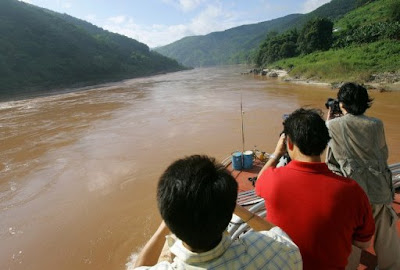 A journalist poses a question to opposition leader Sam Rainsy, who spoke to reporters on Thursday via video link from France, where he is in self-imposed exile. Sam Rainsy said during the press conference that he would not return to Cambodia unless a “political compromise” is reached with the government. (Photo by: Pha Lina)
A journalist poses a question to opposition leader Sam Rainsy, who spoke to reporters on Thursday via video link from France, where he is in self-imposed exile. Sam Rainsy said during the press conference that he would not return to Cambodia unless a “political compromise” is reached with the government. (Photo by: Pha Lina)Friday, 26 March 2010
Meas Sokchea
The Phnom Penh Post
OPPOSITION leader Sam Rainsy said during a video conference Thursday that he would not return to Cambodia in the absence of a “political compromise”, something the ruling Cambodian People’s Party has already come out against.
Speaking to reporters from France, where he is living in self-imposed exile, Sam Rainsy said he would not appear for court hearings stemming from charges filed against him in Phnom Penh Municipal Court. The court charged him earlier this month with falsifying public documents and spreading disinformation. He faces up to 18 years in prison if convicted.
“We will not go to play with the puppet court,” he said. “I must keep my freedom to do research.”
He was referring to his research into Vietnamese border incursions, which he discussed at length again on Thursday. The opposition leader has been sentenced in absentia to two years in prison for his role in uprooting border posts in Svay Rieng province in October, and the most recent charges were prompted by the release of maps his party said offered “unprecedented evidence” of Vietnamese border incursions.
Prime Minister Hun Sen said last month that there would be no compromise for Sam Rainsy, and that the opposition leader would not be able to participate in elections scheduled for 2013.
Council of Ministers spokesman Phay Siphan reiterated that position on Thursday, saying that Sam Rainsy would be tried in accordance with the law.
“He destroyed public property and spread disinformation,” Phay Siphan said.
“He must resolve this problem. I won’t speak about a political compromise. We must take the law as the highest authority,” he added.
Choung Chou Ngy, Sam Rainsy’s defence lawyer, said Thursday that his client had not received any recent summons from the Phnom Penh Municipal Court.
Government lawyer Ky Tech said he had been summoned to answer additional questions about the complaint against Sam Rainsy, but that he did not know when a hearing would be held.
Speaking to reporters from France, where he is living in self-imposed exile, Sam Rainsy said he would not appear for court hearings stemming from charges filed against him in Phnom Penh Municipal Court. The court charged him earlier this month with falsifying public documents and spreading disinformation. He faces up to 18 years in prison if convicted.
“We will not go to play with the puppet court,” he said. “I must keep my freedom to do research.”
He was referring to his research into Vietnamese border incursions, which he discussed at length again on Thursday. The opposition leader has been sentenced in absentia to two years in prison for his role in uprooting border posts in Svay Rieng province in October, and the most recent charges were prompted by the release of maps his party said offered “unprecedented evidence” of Vietnamese border incursions.
Prime Minister Hun Sen said last month that there would be no compromise for Sam Rainsy, and that the opposition leader would not be able to participate in elections scheduled for 2013.
Council of Ministers spokesman Phay Siphan reiterated that position on Thursday, saying that Sam Rainsy would be tried in accordance with the law.
“He destroyed public property and spread disinformation,” Phay Siphan said.
“He must resolve this problem. I won’t speak about a political compromise. We must take the law as the highest authority,” he added.
Choung Chou Ngy, Sam Rainsy’s defence lawyer, said Thursday that his client had not received any recent summons from the Phnom Penh Municipal Court.
Government lawyer Ky Tech said he had been summoned to answer additional questions about the complaint against Sam Rainsy, but that he did not know when a hearing would be held.

















